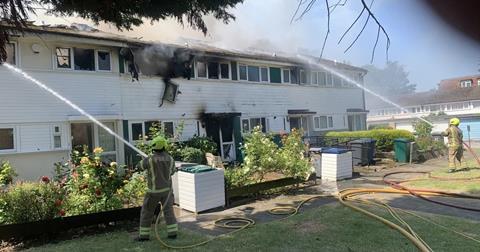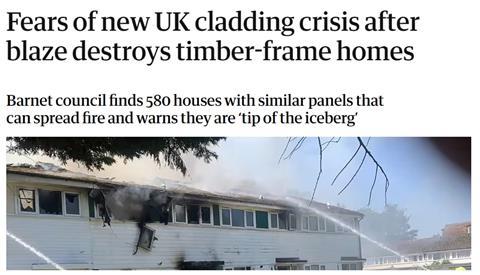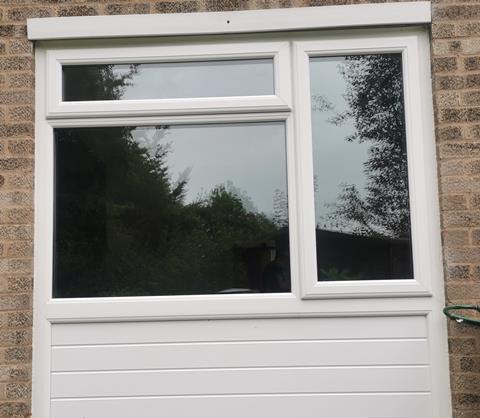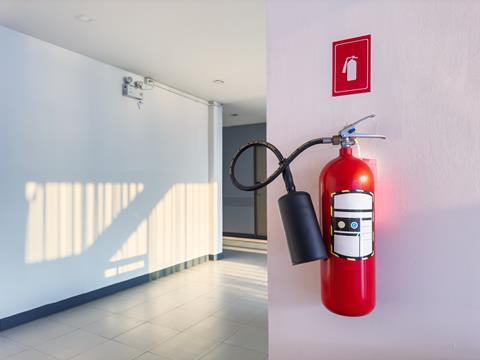When a fire in 2023 destroyed four terraced houses Barnet Council brought the housing sector’s attention to an overlooked fire safety issue: the use of uPVC cladding in low-rise homes. Have other councils heeded its warning? Olivia Barber launched a Freedom of Information investigation to find out

It’s mid-morning on Thursday 8 June 2023. A fire blazes through a row of four terraced houses on Moss Hall Grove in North Finchley. The London Fire Brigade receives 42 calls about the fire. When 10 fire engines and 70 firefighters arrive at the scene, one of the houses has been destroyed. The fire has severely damaged the neighbouring properties. Eight people evacuated the houses. There were no reports of injuries. By 12:55, the fire brigade has brought the fire under control. It said the cause of the fire was undetermined.
This is the London Fire Brigade’s account of the fire that broke out in a row of low-rise, timber-framed homes. There is one crucial detail to be added: the four houses contained uPVC cladding.
After Barnet Council had concluded its investigation into the fire, via the commissioning of a report by the firm Capital Property and Construction, it announced it would remove the uPVC cladding from 153 of its homes. A further 434 privately-owned homes are also affected, seven of which are leasehold properties, and 426 of which are freehold properties, and were sold by the council under the Right to Buy Scheme.

This seemed like quite a serious move, especially since the council committed to spending £3.6m on replacing the cladding. Furthermore, they estimated that homeowners could face remediation costs of between £14,000 and £23,000 each. The council did not stop there. It went on to warn that this type of cladding could be a nationwide problem.
This sparked headlines in national newspapers about "fears of a fresh cladding crisis".
Amid all the noise about the issue, we wanted to find out just how risky uPVC cladding is, and how many other councils are affected by the same issue.

Housing Today sent Freedom of Information Act (FOI) requests to the 32 London borough councils, as well as four other large metropolitan councils, namely Sheffield, Birmingham, Leeds and Manchester. The FOIs asked councils how many homes containing uPVC cladding they own, and what plans, if any, the councils have to remediate uPVC cladding (See ‘Councils' reactions to uPVC', below).
Our research revealed that the use of uPVC cladding is more widespread than just Barnet's homes, with 18 councils across the UK confirming to Housing Today that some of their properties feature uPVC cladding. But many councils seemed less worried than Barnet.
Is this because a fire had not torn through a terrace of houses in their area? Or does Barnet's situation involve more complex fire safety issues, due to the unique combination of timber frame construction, lack of fire-stopping measures, and the uPVC cladding?
Some building safety experts we spoke to agreed that Barnet is right to be concerned about uPVC cladding. But they also contend that this may not be the whole story. There is another related issue. Until now, the government's attention and fire safety legislation have focused on high-rise buildings. The Barnet fire shows that fire risks in low-rises should not be ignored.
Cladding concerns
The combustibility of some types of cladding is well-documented, and this week’s fire in Dagenham adds to a long list of notorious incidents, with the Grenfell distaster that killed 72 people most present in people's minds.
George Edwardes, an engineer and technical director at the Fire Protection Association, says that uPVC cladding can rapidly spread fire across its surface and between homes. “A small fire can develop into a large fire and engulf neighbouring houses,” he says, adding that there is limited guidance on the use of uPVC cladding.
There is no strict rule that says uPVC cladding is or isn’t compliant
George Edwardes, Fire Protection Association
Legislation that covers uPVC use and other types of cladding in buildings under 11m is not prescriptive. In buildings over 11m, combustible cladding is banned. uPVC cladding is combustible, but for low-rise buildings, its combustibility alone does not necessarily mean it fails to meet fire safety requirements. Edwardes points out that “there is no strict rule that says uPVC cladding is or isn’t compliant.” While Aluminium Composite Material (ACM) panels with a polyethylene core - the cladding that was used in the refurbishment of Grenfell Tower - is now banned, plain plastic is not.
Edwardes emphasises that following statutory guidance, in for example the building regulations' Approved Documents, does not always ensure legal compliance - especially if you knowingly use a dangerous material. uPVC cladding, he suggests, could fall into this category, as it has been linked to fires spreading between homes.
However, building regulations mandate that external walls on all buildings must resist the spread of fire, which uPVC cladding does not do, especially when it connects multiple homes. In addition, party walls in low-rise buildings must have an adequate level of fire resistance to prevent fire from spreading between homes. To ensure this, proper fire stopping should be installed between homes - a measure that was lacking in Barnet's Moss Hall Grove properties, according to Capital's report.
Simon Tolson, senior partner at law firm Fenwick Elliott, echoes that the main fear is that uPVC cladding can act as a fuel source, melt, and release toxic fumes. He cites the 1999 Garnock Court fire in North Ayrshire, Scotland, where flames spread via plastic external cladding, reaching the 12th floor. The fire caused one fatality and destroyed nine floors. The window pods and spandrel panel were glass-reinforced plastic, and the window itself uPVC.
Councils’ reactions to uPVC
The affected Barnet Council homes are of timber frame construction and were built between the 1930s and 1960s, uPVC cladding was added to the buildings in the 1980s.
Edwardes says this cladding is quite common in council houses “probably because it was cheap and waterproof, with uPVC being chosen because it’s more sun resistant than other plastics”.
Beyond Barnet: the use of uPVC cladding at other councils

Housing Today obtained Freedom of Information Act responses from 25 London councils, as well as from Sheffield, Manchester, Birmingham and Leeds. Of these, 18 councils confirmed that some of their properties have uPVC cladding.
Our research identified that among the local authorities that provided specific numbers of homes with uPVC cladding, it was identified in 302 low-rise blocks and 3,282 low-rise homes, flats and bungalows.
Among these, Haringey and Tower Hamlets reported the highest numbers of homes with uPVC cladding.
Haringey has uPVC cladding in 740 flats and houses. Tower Hamlets said “some element of uPVC” had been installed in 1,606 of its flats or houses.
Croydon Council says up to 703 of its low and medium-rise blocks could have uPVC cladding, but it couldn’t confirm the exact numbers as stock condition surveys are still underway.
In comparison, other councils have reported lower numbers of homes with uPVC cladding, though their figures are still in the low hundreds:
- Enfield: 68 low-rise blocks and 341 houses
- Newham: 50 low-rise blocks of flats and 152 street properties
- Havering: 56 blocks and 103 individual dwellings
- Hounslow: 92 units in nine low-rise blocks and 152 houses
- Waltham Forest: 118 blocks and 73 houses or bungalows with some type of uPVC wall finish.
Others have less than a hundred homes with uPVC cladding:
- Sutton Council: 96 properties situated in three blocks of flats. It has said all uPVC cladding is to be replaced with non-combustible fibre cement cladding.
- Wandsworth Council: in four blocks so far
- Camden Council: two blocks of flats containing 10 homes and six low-rise houses
- Lewisham Council: four low-rise blocks
- Kingston upon Thames Council: six homes
- Manchester City Council: seven homes
Some councils said they do have uPVC cladding in their homes, but didn’t specify in how many.
- Leeds City Council reported that uPVC is present in its homes “in small quantities”
- Birmingham City Council has identified uPVC cladding in its homes, but it said it could not give a total as its surveys are ongoing.
- Sheffield City Council responded: “We only have plastic and timber cladding on our properties,” but did not specify whether this includes uPVC or provide details on the number of affected homes.
- Brent Council has uPVC cladding on some of its low-rise homes, it did not specify how many.
Our investigation has found that many of the local authorities are conducting surveys to determine if they have uPVC cladding in their homes, and if so, to determine whether it poses a risk. Some but not all the local authorities that responded to our FOI requests gave explanations for their approach to assessing the risks of uPVC. Kensington and Chelsea and Barking and Dagenham Council, stated they did not hold information on the presence of uPVC cladding in their homes. However, Barking and Dagenham said it plans to gather this data in future stock condition surveys.
Sutton Council, which has 96 homes with uPVC cladding, plans to replace all of it with fibre cement cladding. However, many councils are taking a ‘watch and wait’ approach, viewing uPVC cladding as less of a concern unless it is combined with other safety issues.
A spokesperson from Camden Council, which has 16 homes with uPVC cladding, said: “We carried out comprehensive surveys of these homes in May and due to their design being fundamentally different from the Barnet homes, the cladding has a low fire risk rating. Resident safety is our priority and we will of course implement any recommendations made by future fire risk assessments on these homes.”
Unlike Camden’s, Barnet’s properties have uPVC cladding and timber frames, which they said present a higher risk compared to traditional brick and concrete constructions.
Aydin Dikerdem, cabinet member for housing at Wandsworth Council, said: “The safety and security of our residents is our chief priority. The blocks identified have small quantities of uPVC panelling."
He added that the uPVC panelling "may be replaced as part of future routine decorations but does not pose a significant fire risk. Most double glazing in residential blocks is manufactured from the same material [uPVC] and we are unaware of any suggestion that these should be replaced.”
Councillor Ahsan Khan, deputy leader and cabinet member for housing and regeneration at Waltham Forest Council, said that as part of the local authority’s regular fire risk assessments, “we have identified a small number of properties where further investigation is required to ascertain if remedial work is needed to ensure resident safety. We anticipate that this work will be complete by the end of this financial year.”
Khan added: “We work hard to keep all our tenants safe and protected as we tackle the housing crisis and make sure Waltham Forest is a great place to live and age well.”
A Tower Hamlets council spokesperson said: “Where our stock data indicates that properties have uPVC cladding, we have checked that these properties have fire risk assessments, meaning that the potential spread of fire externally has been assessed by a suitably qualified assessor.
“Subsequently, if we determine that an external wall survey is necessary, we will make the appropriate arrangements.”
The spokesperson noted that all blocks of flats have fire risk assessments in place. They also mentioned that six low-rise blocks were initially flagged for external wall surveys but were found to have no uPVC cladding.
The council has 78 houses where stock condition data indicates there is uPVC cladding on the external walls.
Twenty-five of these have been reviewed, and the council does not believe the cladding poses a danger either because of its location or because there is separation from adjacent properties, and 42 do not have uPVC cladding despite stock condition data saying they do.
The council said this is because often assessors and surveyors list material as uPVC when it is steel or aluminium. The council has seven remaining homes to assess.
Councillor Sue Sampson, Hounslow Council’s cabinet member for homelessness and housing Management, said: “Hounslow Council’s Housing Services takes issues regarding the safety of our tenants and homes extremely seriously.
“We are currently reviewing our plans to remediate uPVC cladding, where needed. Fire risk assessments are undertaken across our blocks, and remedial actions that arise from these assessments are acted upon.”
Birmingham City Council stated that its fire risk assessments have determined that the uPVC cladding in its homes does not pose a fire risk.
Different views on the level of risk
Although it is known that uPVC cladding is combustible and can cause fire to spread rapidly along and up houses, that is not the whole story.
Some believe that uPVC cladding may not be as risky as Barnet Council suggests. An independent report on the Moss Hall Grove fire, commissioned by one of the residents and written by a consultant engineer, notes that the causes of the fire spreading are more complex than just the presence of uPVC cladding.
The report, seen by Housing Today, details that the extensive damage was due to three houses being directly exposed to heat and flames from a large external fire. It started when a large load of flammable materials in a yard to the back of the houses caught fire. The expert notes that photographs taken after the fire show no visible flame spread on the remaining uPVC cladding, though it did exhibit heat damage.
The report also points out that Barnet Council did not test cladding samples to assess their combustibility and fire-spreading potential. Given the estimated costs to homeowners of up to £23,000, the independent report describes the absence of these tests as “unfortunate”. The report concludes that the council’s claim that the cladding poses a serious health and safety risk relies “more on speculation than hard evidence”.
Cost consultants at PRP, where Mellor is a partner, estimated that remediation costs would be lower than the £14,000-£23,000 figure cited by Barnet Council. They calculated that replacing the uPVC cladding, fascia, and soffits with fibre cement alternatives, and installing cavity barriers along vertical lines, would cost approximately £11,000 per house, excluding VAT.
The council stated that a separate report by Capital Property and Construction found that the rapid spread of the fire was likely caused by the uPVC cladding, which allowed the fire to move between houses, as well as the enclosed roof eaves and gaps between the top of the party wall and the roof. This report also noted that the timber-framed construction contributed to the fire’s spread.
Barnet said it did not test any uPVC cladding samples from the homes because “stating this was not required due to existing knowledge available on PVC-u products.”
The combination of the three things – fire-stopping issues, timber-framed homes and uPVC cladding has certainly heightened the risk
Andrew Mellor, PRP
Andrew Mellor is a partner at architect practice PRP and leads its development consultancy team. He also sees the Barnet Council situation as being more complex than just the uPVC cladding.
He notes that uPVC cladding complies with current building regulations for homes, stating, “It’s not restricted at all; you can still use it today.”
Mellor acknowledges that uPVC cladding carries “some level of risk”, adding that it “probably doesn’t pose a greater level of risk than timber cladding in the same situation.” He explains, “The combination of the three things – fire-stopping issues, timber-framed homes and uPVC cladding has certainly heightened the risk.”
In addition, he says: “If you haven’t got the cavity barrier behind the cladding that heightens the risk and then obviously you’ve got the cladding itself”.
Although Mellor thinks the council is right to look into the use of uPVC cladding in its homes, his view is that “it’s probably a bit of an overreaction to the situation, stripping all of the cladding off, because there will be other ways of potentially mitigating that risk”.
He says that the low-rise homes of this type of construction should have a cavity barrier between the homes because UK building regulations require the external wall system to restrict the hidden spread of smoke and fire. The reality, however, is that many of the homes will not have cavity barriers due to a lack of statutory guidance at that time uPVC was installed.
However, homes built since that time should have cavity barriers installed, as should those which have subsequently been reclad.
Another way of mitigating the risk would be by putting a cavity barrier behind the cladding, he explains. uPVC cladding is often attached to timber battens, which creates a gap behind it. A cavity barrier is needed to stop fire and smoke from spreading through this gap. The barrier should also extend into any voids in the soffit and fascia if uPVC is used on the roof.
He also points out that councils should consider the lifespan of uPVC, which is typically around 25 years. “How much longer will the cladding last? It’s extremely wasteful to just take it off and dump it”.
These potential solutions suggest that the risk may not be so high that immediate removal is the only option. However, could there be a missing link in the discussion? Are low-rise homes considered less risky due to the government’s focus on high-rise buildings?
Low-rise and overlooked
The building regulations and Approved Document B apply to all buildings, including low-rise homes. They require buildings to meet general fire safety standards, including having escape routes, using fire-resistant materials on party walls and adequate fire stopping to prevent internal and external fire spread, and access and facilities for fire and rescue services.
Following the Grenfell Tower fire, extensive lobbying led to a ban on combustible cladding for external facades of buildings over 18m, introduced through the Building (Amendment) Regulations 2018.
In 2022, this ban was expanded to cover buildings with at least one floor above 11m, as detailed in the Building (Amendment) Regulations 2022 and Approved Document B. However, similar regulatory changes have not been applied to buildings under 11m.
Height is not a good indicator of risk, and we were disappointed that the previous government only made buildings over 18m subject to the new Building Safety Regime
Claire Holland, Local Government Association
In a recent statement provided to Housing Today, councillor Claire Holland, housing spokesperson for the Local Government Association, said: “Councils treat the safety of their residents seriously, and where new building safety risks are identified will look to make them safe.”
Holland noted that although the Regulator of Social Housing and Building Safety Regulator oversee the work to identify buildings over 11m that have uPVC and other dangerous forms of cladding, this regime does not apply to low-rise buildings.
Holland added that “height is not a good indicator of risk, and we were disappointed that the previous government only made buildings over 18m in height subject to the new Building Safety Regime overseen by the BSR.”
Mellor explains that his work with the Department for Levelling Up, Housing and Communities and the Welsh Government has show that its main priority is preventing deaths and serious injuries. He notes that for low-rise homes the expectation is that people can escape from a house.
He adds: “I know people die in house fires, but they typically die as a result of a fire in the house […] not from fires outside the house”.
While governments focus on life safety, “the insurance industry is, of course, concerned with asset protection and potential payouts,” Mellor explains. He suggests that this financial consideration might influence some councils’ decisions to investigate and replace uPVC cladding, in the absence of any specific legislation banning its use.
Barnet Council stated that the Moss Hall Grove fire in June 2023 did not lead to an increase in its insurance premiums. However, some freeholders reported that it was more difficult to find insurance for their homes.
Edwardes believes there is a “blind spot” in the legislation when it comes to low-rise homes, leaving it up to councils to decide whether to investigate uPVC cladding and other fire safety concerns.
The Housing Act 2004, which includes the Housing Health and Safety Rating System (HHSRS), applies to low-rise buildings. Barnet Council used this rating system and found that fire-stopping issues, timber frames, and uPVC cladding in its homes were category one hazards, indicating a serious and immediate risk to occupant safety.
However, Edwardes points out that the HHSRS is a broad tool and does not specifically focus on fire safety or external walls, but rather on overall housing conditions. He added that a tenant can request an HHSRS assessment but that it is not a regular requirement.
Edwardes adds that low-rise, single-occupancy homes generally fall outside the scope of the Fire Safety Order 2005 and are not required to conduct regular risk assessments under this law. The only assessment available would be a HHSRS assessment if the local authority or a tenant identified a particular concern.
He believes this highlights a flaw in how risk is assessed: the government has chosen a “simplified system that uses height as the benchmark.” However, in cases where a building is low but wide, such as a row of terraced houses, the risk does not get picked up.
The cladding crisis continues

So, where does this leave low-rise buildings with combustible cladding, such as uPVC?
At present, these buildings fall low on the priority list. PRP's Mellor highlights that the advice from government was always to look at highest buildings first. He adds that if you were to ask Dame Judith Hackett, who wrote an independent review of building regulations and fire safety after Grenfell, she might argue that these low-rise homes are not inherently a fire safety risk.
However, recent incidents, such as the situation in Barnet and the fire at the Spectrum Building in Dagenham, show that fire safety issues are not confined to high-rises—they affect all building types.
While fire safety discussions often focus on the government's emphasis on life safety versus insurance companies' focus on asset protection, these two aspects are not at odds. Both need to be addressed to ensure homes are safe for residents.
With the final report from the Grenfell Inquiry due to be published next week, it is clear that, even with the focus on high-rises, the country's progress on removing combustible cladding from homes has been too slow. At the same time, it highlights that making homes under 11m fire-safe has, for the most part, been overlooked. To address the issue, there would need to be a shift in focus to ensure that all buildings, regardless of their height, meet stringent fire safety standards to protect people's lives and their homes.



























No comments yet